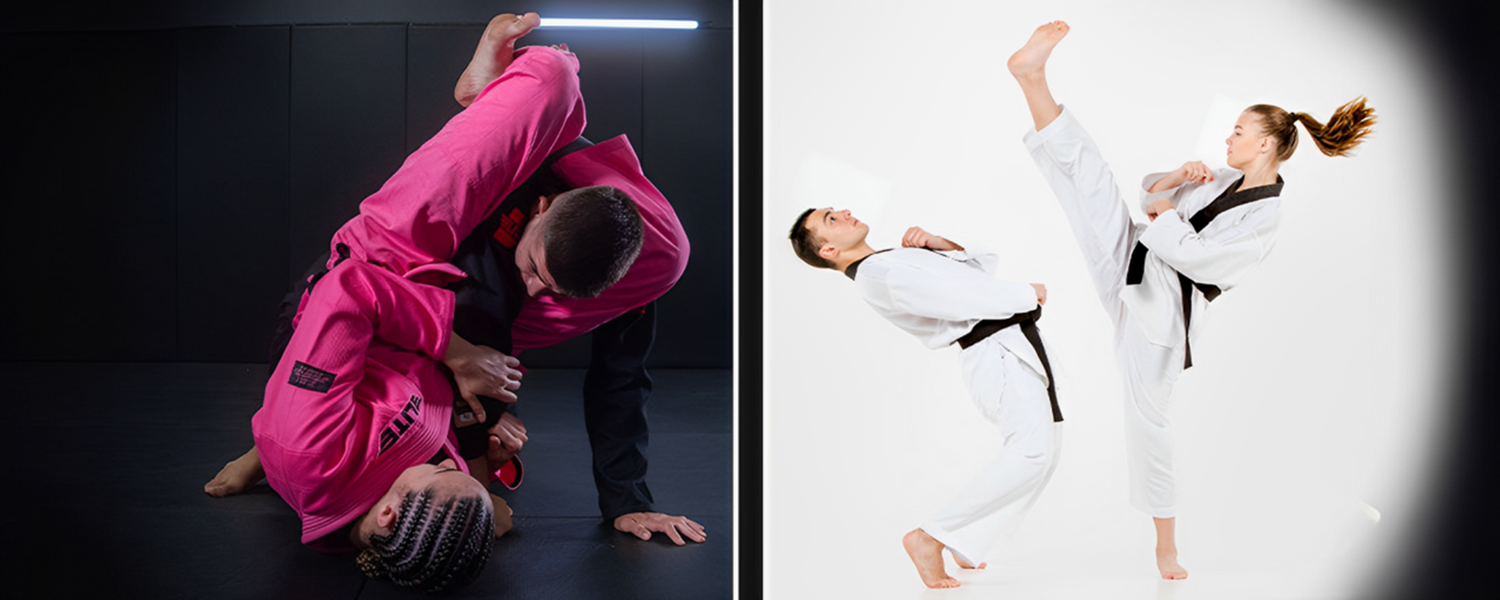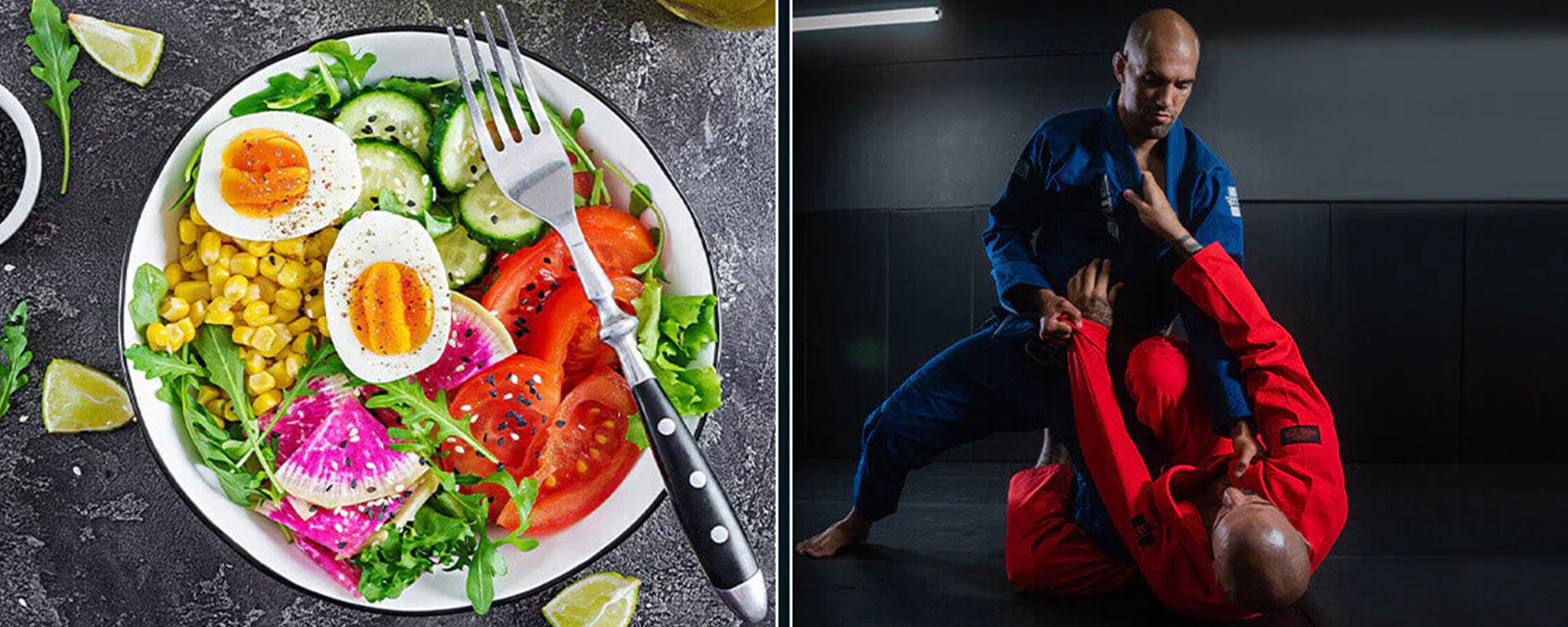Table of content
1. Overview
The most well-known martial arts forms are BJJ, jiu-jitsu, karate, taekwondo, Kung-fu, mixed martial arts, and wrestling. All martial arts forms have different training and self-defense techniques.
These days, both jiu-jitsu and taekwondo are quite popular. But many people are always curious to know which discipline is better. So, it is quite difficult to make a decision about the effectiveness of jiu-Jitsu vs. taekwondo.
The emphasis of taekwondo is more on kicking whereas jiu-jitsu has an emphasis on ground fighting and grappling. So, it depends on the individual to decide to train in either jiu-jitsu or taekwondo.
The article will help you learn about the origin, history, philosophy, rules, similarities, differences, pros, and cons of both jiu-jitsu vs. taekwondo.
2. Things to Know About Jiu-Jitsu
2.1. Origin
The word jiu-jitsu' is derived from the Japanese language, translating as “gentle art.” It started in the 15th century during the Sengoku period in Japan.
2.2. History
- The samurai warriors in 17th century Japan were taught jiu-jitsu’s grappling and striking techniques to subdue any opponent carrying weapons.
- In the mid-1800s, various forms of “Ryu” were practiced. In the late 1880s, Jigoro Kano also developed his style of “Ryu.”
- Then, Mitsu Maeda, a student of Jigoro Kano migrated from Japan to Brazil in 1914. Mitsu Maeda trained Carlos Gracie in jiu-jitsu.
- The first academy for jiu-jitsu was founded by Carlos Gracie in Brazil in 1925. Now, the Gracie family transformed this traditional fighting style into a well-organized BJJ with an appropriate curriculum and values.
2.3. Philosophy
The following values and ethics are taught to jiu-jitsu students as the philosophies of jiu-jitsu.
- Community: The bond between the community and jiu-jitsu teams is very strong. The community is not concerned about someone’s religion, family background, financial status, language, education, and nationality. The most important element in the jiu-jitsu community is dedication and commitment to the martial art’s philosophies.
- Humility: All mentors and trainers during jiu-jitsu training sessions teach you to be humble, kind, and courteous to others.
- Empathy: Usually, jiu-jitsu fighters are thought to be emotionless, and don’t feel the pain of others. But, jiu-jitsu helps a fighter to feel the emotions and feelings of their teammates to stay goal-driven and energetic.
- Selflessness: Being selfless is the noblest personality trait, so jiu-jitsu teaches its practitioners to always think about others and help them whenever they are in need.
2.4. Techniques
- Jiu-jitsu techniques comprise different forms of submissions and takedowns to control the opponent with the least amount of effort possible.
- Joint locks include armbars, kimura, Americana (keylock), shoulder locks, and foot locks.
- Chokes include the rear-naked choke (RNC), guillotine choke, triangle choke, arm triangle, and lapel choke.
- Different techniques for takedowns and throws are used in jiu-jitsu to take dominate an opponent on the ground.
2.5. Forms
The following are the two major forms of jiu-jitsu.
Gi Jiu-Jitsu
- In this form, fighters wear the traditional BJJ gi uniform.
- They are allowed to grab hold of the opponent’s uniform.
- It is easier to control the opponent while grabbing onto the uniform.
- It is more flexible.
- It relies more on defensive skills.
No-Gi Jiu-Jitsu
- During a No-Gi match, fighters wear shorts and a rash guard or t-shirt.
- Opponents are not allowed to grab each other’s clothing.
- It relies more on offensive skills.
- The movements used in No-Gi jiu-jitsu are faster.
2.6. Uniform
- A traditional gi uniform is called a kimono.
- It includes cotton trousers, a jacket, and a belt.
- A belt is also used to hold the jacket altogether.
- A No-Gi uniform consists of a rash guard, shorts, and spats.
2.7. Belt Ranking System
- Basically, a belt ranking system indicates a BJJ fighter's level of expertise and skills.
- The regulatory body that supervises the belt system globally is the International Brazilian Jiu-Jitsu Federation (IBJJF).
- The first belt awarded to a beginner in BJJ is a white belt.
- The main five belt ranks are white, blue, purple, brown, and black.
- It takes almost 10 years for a BJJ fighter to reach the black belt rank.

2.8. Bout Points for Jiu-Jitsu
A normal BJJ bout lasts for almost 5-10 minutes depending on the ranks of the opponents.
Both opponents try to finish the match by subduing the opponent or earning more points.
The following are how points are assigned in a match:
- Mount/Back Mount: 4 points
- Guard Pass: 3 points
- Sweep: 2 points
- Knee on Belly: 2 points
- Takedown/Judo Throw: 2 points
- Advantage point (for trying different positions or to get almost submission)

2.9. Competitions
Jiu-jitsu is not a sport in the Olympics. But it has been featured at the following worldwide tournaments.
- World Jiu-Jitsu Championship (aka The Mundials)
- Pan-American Championship.
3. Things to Know About Taekwondo
3.1. Origin
The word taekwondo is a combination of three Korean words. The word Tae (태, hanja 跆), which means to kick, Kwon (권, hanja 拳), means to strike with the hand, and do (도, hanja 道), which means to hit. So, taekwondo is a martial art that incorporates kicks and punches.

3.2. History
- The historical roots of Taekwondo trace back to 50 B.C.
- The original name of taekwondo is “Taek Kyon.”
- It is one of the oldest martial arts forms.
- Warriors in ancient Korea used techniques that are relatively close to the modern form of taekwondo.
- The Korean Taekwondo Association was established in 1965.
- In 1973, it was transformed into the World Taekwondo Federation.
- Today, Taekwondo is an official sport in the Olympics.
3.3. Philosophy
- Courtesy (Ye-Wee) means to give respect to everyone by acting courteously. manner, whether a taekwondo practitioner is inside or outside the dojang.
- Integrity (Yom-Chee) means that a taekwondo fighter must know to differentiate between right and wrong and must be able to take action against immorality.
- Perseverance (Een-Nay) means to be determined and strive hard to reach your goals.
- Self-Control (Gook to Gee) means to have conscious control over your words, actions, and life.
- Indomitable Spirit (Beckjool bool gool) means to stay positive and motivated to face all the challenges of life with courage and determination.

3.4. Techniques
This martial art uses powerful kicks to attack the lower body. The arms are used defensively, blocking any attacks from an opponent. Taekwondo consists of 3,200 different techniques involving kicks, punches, and open-handed strikes.
Sidekicks/Front Kicks: Sidekicks involve positioning the foot in a horizontal direction whereas front kicks are positioned with the foot in a vertical direction. It is helpful to attack an opponent from a distance.
Punches: Punches are also known as “Jirugi” in taekwondo. Different types of punches are utilized, such as reverse punches, rear arm punches, or straight punches.
Roundhouse Kicks: Roundhouse kicks are also called “Dollyeo Chagi,” which means turning kicks.
Spinning/Jumping kicks: A spinning back kick, horse kick, donkey kick, mule kick, or dwi chagi) can be performed when a fighter kicks backward with the foot or heel. These kicks are considered the most powerful ones.
3.5. Forms
There are two forms of Taekwondo.
Kukkiwon
The first form is known as Kukkiwon which was developed in the late 1960s and has 38 different forms.
The World Taekwondo Headquarters served as the governing body.
The WTH also awards black belts to taekwondo fighters.
This form is a sport in the Summer Olympic Games.
Chang Hon (Hyeong/Tel)
Chang Hon was developed by the International Taekwondo Federation.
It has 24 forms.
It was introduced by Choi Hong Hi in 1960.
The ITF used to promote MMA as a sport by conducting several seminars, competitions, and training.
3.6. Scoring in Taekwondo
In taekwondo, both fighters wear a trunk protector and an electronic scoring system is placed on it. The scoring in each match is adjusted according to the weight category.
These are the points that are assigned if you score a valid hit on the trunk protector:
- 1 point for a valid punch
- 2 points for a valid kick
- 4 points for a valid turning kick
Scores for kicking the head:
- 3 points for a valid kick
- 5 points for a valid turning kick
- 1 point is for a penalty (Gam-Jeom) against the opponent.
- Moreover, a panel of four judges also takes into account scoring a point for head kicks and fights where electronic scoring is not working.
- A score is awarded only when three judges come to the same decision.

3.7. Uniform
Taekwondo uniforms are called Dobok.
- A dobok consists of a jacket, trousers, and a colored belt to signify rank.
- A dobok is lightweight.
- It is adjusted according to the weight and height of a fighter.
- A dobok is made of a mixed fabric of cotton and polyester.
- It is durable, breathable, and helpful in absorbing sweat.
- Jackets come in two styles: pull-over V-necks and cross-overs.

3.8. Belt Ranking System
The belt ranking system of taekwondo is divided into three categories.
Gup Level
- White belt
- Yellow belt
- Yellow belt with a green stripe
- Green belt
- Green belt with a blue stripe
- Blue belt
- Blue belt with a red stripe
- Red belt
- Red belt with black or white stripe
Poom – Junior black belt for students under 15 years old.
Dan – Adult belt ranking system awarded after the following years:
- 1st Dan Black Belt (1 year)
- 2nd Dan Black Belt (3-4 years of experience)
- 3rd Dan Black Belt (4-5 years of experience)
- 4th Dan Black Belt (5-6 years of experience)
- 5th Dan Black Belt (6-7 years of experience)
- 6th Dan Black Belt (7-8 years of experience)
- 7th Dan Black Belt (8-9 years of experience)
- 8th Dan Black Belt (9-10 years of experience)
- 9th Dan Black Belt (10-12 years of experience)

3.9. Competitions
Taekwondo became an official sport in the Olympics in 1988.
The World Taekwondo Federation organized many world championships:
- The World Taekwondo Championship
- The World Taekwondo Cadet Championship
- The World Taekwondo Beach Championship
- The World Taekwondo Women's Open Championship
- The World Taekwondo Junior Championship
- The World Taekwondo Grand Slam
- The World Taekwondo Poomsae Championship
- The World Taekwondo Grand Prix
4. Similarities: Jiu-Jitsu Vs Taekwondo
- Jiu-jitsu and taekwondo are helpful in teaching self-defense and building character.
- Self-respect, discipline, spiritualism, work ethics, hard work, and dedication are attributes of jiu-jitsu and taekwondo.
- Both jiu-jitsu and taekwondo have a strong community network.
- Both jiu-jitsu and taekwondo require the support of the fighting community to achieve higher goals.
- Both martial arts have a uniform and belt ranking system.
- Both martial arts are useful ways to defend yourself without the use of weapons.
- Both jiu-jitsu and taekwondo are very helpful martial arts disciplines for children to learn self-defense that maintains their physical and mental health.
- Both jiu-jitsu and taekwondo have organized national and international level competitions all around the world.
5. Differences: Jiu-Jitsu Vs Taekwondo
- All the emphasis in taekwondo is on kicks and head strikes, whereas jiu-jitsu requires grapples and holds.
- Jiu-jitsu is a combination of different martial arts like judo, Japanese jiu-jitsu, and wrestling, whereas taekwondo is a combination of other martial arts like karate, kung-fu, taekkyon, subak, and gwonbeop.
- Jiu-jitsu focuses on ground fighting whereas Taekwondo is about attacking your opponent on your feet.
- Taekwondo is a Korean martial art, whereas jiu-jitsu is from Japan.
- The different forms of taekwondo (Hyeong, Poomsae, and Teul) begin with learning blocking techniques.
6. Pros and Cons: Jiu-Jitsu Vs Taekwondo
6.1. Pros
- Jiu-jitsu is more practical and can be easily used in real-life situations to defend oneself against taller or heavier assailants.
- Jiu-jitsu fighters can easily control the direction of a fight using their grappling techniques.
- Jiu-jitsu submissions are extremely useful in ground fighting.
- Jiu-jitsu training comprises practical and hands-on experience with trainers and teammates.
- Jiu-jitsu is suitable for everyone, including kids, women, and teenagers.
- Jiu-jitsu heavily depends on physical strength, elasticity, and muscular exercises.
- Jiu-jitsu is helpful in reducing weight, burning calories, and getting rid of fat.
- Jiu-jitsu is dedicated to practical training and real-life principles.
- Jiu-jitsu teaches both physical and mental resilience, strength, and persistence.
- Taekwondo has a lot of benefits for physical health, improving bodily balance, flexibility, stamina, strength, and posture.
- Taekwondo also helps improve self-confidence, self-esteem, focus, concentration, and self-discipline.
- The philosophy of taekwondo is not based on violence and hurting others, so it does not support any unnecessary violence.
- Taekwondo also helps improve your socialization skills.
6.2. Cons
- Jiu-jitsu does not teach fighters to defend themselves from kicks and punches.
- Jiu-jitsu practitioners cannot defend themselves against an opponent with a weapon.
- Jiu-jitsu is not useful when dealing with two or three attackers.
- Taekwondo does not have a long or complex list of techniques.
- Taekwondo is limited only to kicks and head strikes.
- Grappling techniques and hand-to-hand combat are not applicable in taekwondo.
- Taekwondo is based on rigid rules that restrict the learning of self-defense techniques.
- Taekwondo fighters may be more prone to minor or major injuries.
- In Taekwondo, students can be rapidly promoted to the rank of black belt.
7. Which One is Better in Self-Defense? Jiu-Jitsu Vs Taekwondo
- Having expertise in any martial art will always give you an advantage when defending yourself against an unknown attacker.
- Both jiu-jitsu and taekwondo gained popularity over the past few years, so it is more difficult to make a decision regarding whether jiu-jitsu or taekwondo is better for self-defense.
- While in the MMA community, it is widely accepted that jiu-jitsu is better in terms of self-defense compared to taekwondo.
- A jiu-jitsu fighter can easily fight a bigger or heavier attacker on the ground by using different submission techniques. In contrast, a taekwondo fighter will just attack with kicks and head strikes.
- Even statistics show that 90% of fights are fought on the ground. So, jiu-jitsu fighters will always have the advantage in a fight.
- Moreover, jiu-jitsu is all about using the right techniques and strategies at the right time, instead of relying on physical strength. Basically, jiu-jitsu prefers technique rather than athleticism.
- All practitioners can easily defend themselves, no matter their size, weight, height, and gender.
- In Taekwondo, powerful kicks take a lot of effort, time, and energy to subdue an attacker, sometimes kicks can cause fighters to lose their balance which can put them in a risky position.
- Most taekwondo teachers only offer point sparring at their schools, making them less effective in a real fighting scenario
8. Which One is Better in a Street Fight? Jiu-Jitsu Vs Taekwondo
- Jiu-jitsu is considered to be more useful and effective in street fights as it uses a variety of submissions, throws, and wrestling techniques.
- A BJJ fighter can easily dominate an attacker in a street fight by using chokes and joint locks.
- As taekwondo relies more on kicking and lower-body attacks, it may put fighters at a disadvantage in a street fight.
- Thus, taekwondo has a low level of effectiveness in street fights.
9. Conclusion
Today, both taekwondo and jiu-jitsu are considered well-known martial arts with millions of practitioners all across the world. So, it is quite clear that both forms are different in many aspects, but it is not always clear which one is more effective.
So, it depends on individual goals when opting for a specific martial art form. You need to decide for yourself whether you want to engage in fitness activities or learn more about self-defense, or want to start competing in professional fights.
The moment you prioritize your goals, then you can decide between jiu-jitsu and taekwondo.













Leave a comment
This site is protected by hCaptcha and the hCaptcha Privacy Policy and Terms of Service apply.